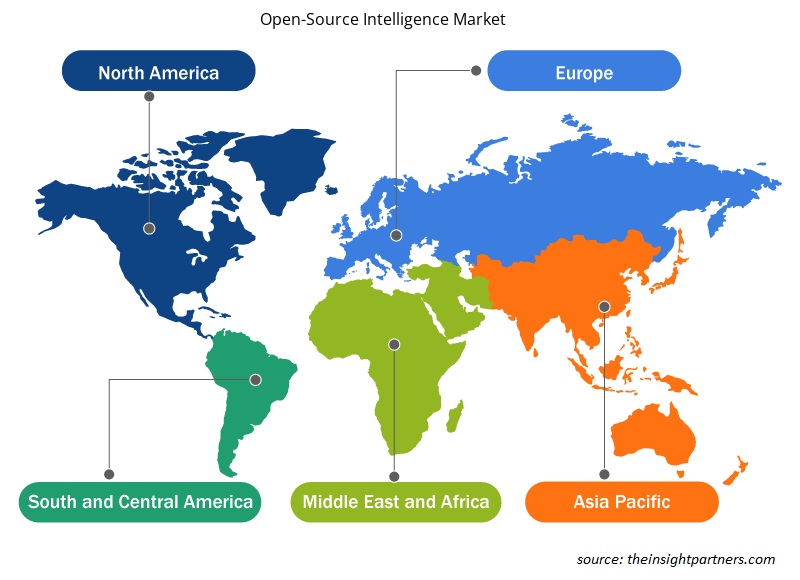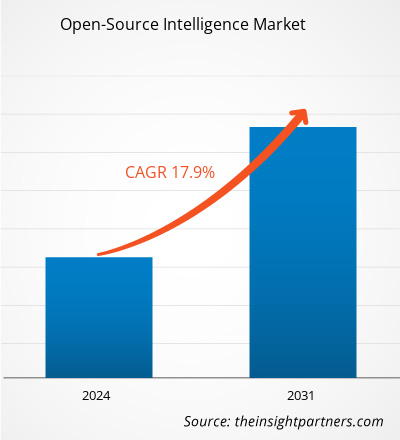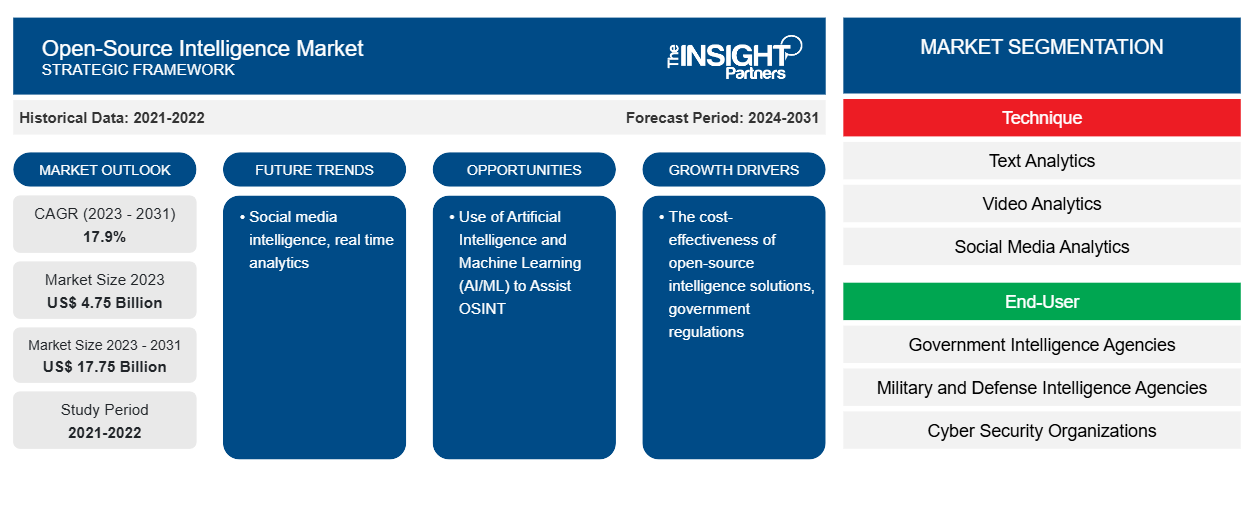Der Markt für Open-Source-Intelligence soll von 4,75 Milliarden US-Dollar im Jahr 2023 auf 17,75 Milliarden US-Dollar im Jahr 2031 anwachsen. Für den Zeitraum 2023–2031 wird ein durchschnittliches jährliches Wachstum von 17,9 % erwartet. Social-Media-Intelligence und Echtzeitanalysen werden voraussichtlich weiterhin ein wichtiger Trend auf dem Markt bleiben.
Open-Source-Intelligence-Marktanalyse
Informationen, die aus der Erfassung, Bewertung und Analyse öffentlich zugänglicher Daten zur Beantwortung einer bestimmten Geheimdienstanfrage gewonnen werden, werden als Open-Source Intelligence (OSINT) bezeichnet. Als Cybersicherheitstool wird OSINT häufig von Unternehmen verwendet, um Sicherheitsbedrohungen zu bewerten und Schwachstellen in ihrer IT-Infrastruktur zu finden. Hacker und Cyberkriminelle verwenden OSINT-Techniken auch zum Phishing, für Social Engineering und zum Aufdecken potenzieller Ziele für Cyberangriffe. Über die Cybersicherheit hinaus kann Open-Source Intelligence auch in Bereichen wie Strafverfolgung, Marketing, nationale Sicherheit, Medien und akademische Studien eingesetzt werden.
Open-Source-Intelligence-Marktübersicht
Desinformations- und Fehlinformationskampagnen haben in den letzten Jahren als Gefahr für die nationale Sicherheit und die Gesellschaft im Allgemeinen zunehmend Aufmerksamkeit auf sich gezogen. In den letzten Jahren haben sich diese Risiken aufgrund anhaltender politischer Unruhen geändert, die die Verbreitung irreführender Informationen ermöglicht haben. Infolgedessen ist das Ökosystem rund um Desinformation und Gegen-Desinformation professioneller geworden. Dies treibt die Nachfrage nach dem Open-Source-Geheimdienstmarkt voran.
Passen Sie diesen Bericht Ihren Anforderungen an
Sie erhalten kostenlos individuelle Anpassungen an jedem Bericht, einschließlich Teilen dieses Berichts oder einer Analyse auf Länderebene, eines Excel-Datenpakets sowie tolle Angebote und Rabatte für Start-ups und Universitäten.
-
Holen Sie sich die wichtigsten Markttrends aus diesem Bericht.Dieses KOSTENLOSE Beispiel umfasst eine Datenanalyse von Markttrends bis hin zu Schätzungen und Prognosen.
Treiber und Chancen des Open-Source-Intelligence-Marktes
Kosteneffizienz von Open-Source-Intelligence-Lösungen begünstigt den Markt
Im Vergleich zu anderen Formen der Informationsbeschaffung ist OSINT kostengünstiger, da es sich auf Informationen konzentriert, die der Öffentlichkeit leicht zugänglich sind. Darüber hinaus ist es weitaus praktikabler, da alle Software und Tools, die zur Unterstützung der Sammlung von Open-Source-Informationen erforderlich sind, der breiten Öffentlichkeit in erster Linie zu einem fairen Preis angeboten werden. Daher ist OSINT eine wichtige Ressource für Unternehmen aller Art und Größe. Durch die Verbesserung anderer Arten von Informationen kann OSINT etablierteren Unternehmen dabei helfen, sich ihrer digitalen Fußabdrücke, Schwachstellen und Bedrohungen bewusster zu werden.
Einsatz künstlicher Intelligenz und maschinellen Lernens (KI/ML) zur Unterstützung von OSINTOSINT
Mit der Weiterentwicklung der OSINT-Technologie schlagen immer mehr Menschen vor, KI und ML zur Unterstützung der OSINT-Forschung einzusetzen. Öffentlichen Berichten zufolge wird künstliche Intelligenz bereits von Geheimdiensten und Regierungsorganisationen verwendet, um Social-Media-Daten zu sammeln und zu verarbeiten. KI und ML werden von Militärgruppen verwendet, um organisierte Cyberkriminalität, falsche Propaganda, Terrorismus und andere Bedrohungen der nationalen Sicherheit auf Social-Media-Plattformen zu erkennen und zu bekämpfen.OSINT technology develops, a growing number of people are suggesting that AI and ML be used to support OSINT research. Public reports state that artificial intelligence is already being used by intelligence and government organizations to collect and process social media data. AI and ML are being used by military groups to detect and counteract organized cybercrime, false propaganda,
Segmentierungsanalyse des Open-Source-Intelligence-Marktberichts
Schlüsselsegmente, die zur Ableitung der Open-Source-Intelligence-Marktanalyse beigetragen haben, sind Technik und Endbenutzer.
- Basierend auf der Technik ist der Open-Source-Intelligence-Markt in Textanalyse, Videoanalyse, Social-Media-Analyse, Geodatenanalyse, Sicherheitsanalyse und andere unterteilt. Das Segment Sicherheitsanalyse hatte im Jahr 2023 den größten Anteil.geospatial analytics, security analytics, and others. The security analytics segment held the largest share in 2023.
- Basierend auf dem Endbenutzer ist der Markt in staatliche Geheimdienste, Militär- und Verteidigungsgeheimdienste, Cybersicherheitsorganisationen, Strafverfolgungsbehörden, private spezialisierte Unternehmen, Finanzdienstleister und andere unterteilt.cyber security organizations, law enforcement agencies, private specialized businesses, financial services, and others.
Open-Source-Intelligence-Marktanteilsanalyse nach geografischer Lage
Der geografische Umfang des Open-Source-Intelligence-Marktberichts ist hauptsächlich in fünf Regionen unterteilt: Nordamerika, Asien-Pazifik, Europa, Naher Osten und Afrika sowie Süd- und Mittelamerika.
Nordamerika hält im Jahr 2023 einen bedeutenden Anteil am Open-Source-Intelligence-Markt. Länder wie die USA und Kanada verfügen über eine hervorragende IT-Infrastruktur zur Förderung und Entwicklung von Lösungen wie OSINT. Darüber hinaus verfügen diese Länder über ein beträchtliches Digitalisierungsbudget in ihren Verteidigungs- und Militärsektoren, was die Nachfrage in der Region antreibt.OSINT. Moreover, these countries have a significant digitalization budget in their defense and military sectors, which is driving the demand in the region.
Regionale Einblicke in den Open-Source-Intelligence-Markt
Die regionalen Trends und Faktoren, die den Open-Source-Intelligence-Markt während des Prognosezeitraums beeinflussen, wurden von den Analysten von Insight Partners ausführlich erläutert. In diesem Abschnitt werden auch die Marktsegmente und die Geografie des Open-Source-Intelligence-Marktes in Nordamerika, Europa, im asiatisch-pazifischen Raum, im Nahen Osten und Afrika sowie in Süd- und Mittelamerika erörtert.

- Holen Sie sich regionale Daten zum Open-Source-Intelligence-Markt
Umfang des Open-Source-Intelligence-Marktberichts
| Berichtsattribut | Details |
|---|---|
| Marktgröße im Jahr 2023 | 4,75 Milliarden US-Dollar |
| Marktgröße bis 2031 | 17,75 Milliarden US-Dollar |
| Globale CAGR (2023 - 2031) | 17,9 % |
| Historische Daten | 2021-2022 |
| Prognosezeitraum | 2024–2031 |
| Abgedeckte Segmente |
Nach Technik
|
| Abgedeckte Regionen und Länder |
Nordamerika
|
| Marktführer und wichtige Unternehmensprofile |
|
Dichte der Akteure auf dem Open-Source-Intelligence-Markt: Die Auswirkungen auf die Geschäftsdynamik verstehen
Der Markt für Open-Source-Intelligence wächst rasant. Dies wird durch die steigende Nachfrage der Endnutzer aufgrund von Faktoren wie sich entwickelnden Verbraucherpräferenzen, technologischen Fortschritten und einem größeren Bewusstsein für die Vorteile des Produkts vorangetrieben. Mit der steigenden Nachfrage erweitern Unternehmen ihr Angebot, entwickeln Innovationen, um die Bedürfnisse der Verbraucher zu erfüllen, und nutzen neue Trends, was das Marktwachstum weiter ankurbelt.
Die Marktteilnehmerdichte bezieht sich auf die Verteilung der Firmen oder Unternehmen, die in einem bestimmten Markt oder einer bestimmten Branche tätig sind. Sie gibt an, wie viele Wettbewerber (Marktteilnehmer) in einem bestimmten Marktraum im Verhältnis zu seiner Größe oder seinem gesamten Marktwert präsent sind.
Die wichtigsten Unternehmen auf dem Open-Source-Intelligence-Markt sind:
- Hyland Software, Inc.
- Cellebrite
- Expert System SpA
- Google LLC
- Maltego Technologies
- NetSentries Technologies FZCO
Haftungsausschluss : Die oben aufgeführten Unternehmen sind nicht in einer bestimmten Reihenfolge aufgeführt.

- Überblick über die wichtigsten Akteure auf dem Open-Source-Intelligence-Markt
Neuigkeiten und aktuelle Entwicklungen zum Open-Source-Intelligence-Markt
Der Open-Source-Intelligence-Markt wird durch die Erhebung qualitativer und quantitativer Daten aus Primär- und Sekundärforschung bewertet, die wichtige Unternehmenspublikationen, Verbandsdaten und Datenbanken umfasst. Nachfolgend sind einige der Entwicklungen auf dem Open-Source-Intelligence-Markt aufgeführt:
- Das Open-Source-Intelligence-Unternehmen Digital Clues AG („Digital Clues“) hat eine formelle Vereinbarung zum Verkauf seiner Vermögenswerte an Cellebrite (Nasdaq: CLBT) unterzeichnet, einen führenden Anbieter von Digital Intelligence (DI)-Lösungen für den öffentlichen und privaten Sektor. Die Übernahme soll dazu beitragen, Cellebrites globale Präsenz in den Geheimdienst- und Ermittlungsabteilungen der Strafverfolgungsbehörden auszubauen, die branchenführende Digital Intelligence-Plattform des Unternehmens zu stärken und seine Position als End-to-End-Technologiepartner zu festigen, der in der Lage ist, den gesamten Ermittlungsablauf zu digitalisieren. (Quelle: Cellebrite, Pressemitteilung, Oktober 2021)
- Maltego Technologies hat offiziell die Pläne Maltego Professional und Organization eingeführt, um bestehenden und neuen Benutzern mehr Ermittlungsmöglichkeiten, Daten und Dienste bereitzustellen. (Quelle: Maltego Technologies, Pressemitteilung, Mai 2024)
Abdeckung und Ergebnisse des Open-Source-Intelligence-Marktberichts
Der Bericht „Open-Source Intelligence-Marktgröße und -prognose (2021–2031)“ bietet eine detaillierte Analyse des Marktes, die die folgenden Bereiche abdeckt:
- Open-Source-Intelligence-Marktgröße und -prognose auf globaler, regionaler und Länderebene für alle wichtigen Marktsegmente, die im Rahmen des Projekts abgedeckt sind
- Open-Source-Intelligence-Markttrends sowie Marktdynamiken wie Treiber, Einschränkungen und wichtige Chancen
- Detaillierte PEST/Porters Five Forces- und SWOT-Analyse
- Open-Source-Intelligence-Marktanalyse, die wichtige Markttrends, globale und regionale Rahmenbedingungen, wichtige Akteure, Vorschriften und aktuelle Marktentwicklungen abdeckt
- Branchenlandschaft und Wettbewerbsanalyse, einschließlich Marktkonzentration, Heatmap-Analyse, prominenten Akteuren und aktuellen Entwicklungen für den Open-Source-Intelligence-Markt
- Detaillierte Firmenprofile
- Historische Analyse (2 Jahre), Basisjahr, Prognose (7 Jahre) mit CAGR
- PEST- und SWOT-Analyse
- Marktgröße Wert/Volumen – Global, Regional, Land
- Branchen- und Wettbewerbslandschaft
- Excel-Datensatz
Aktuelle Berichte
Erfahrungsberichte
Grund zum Kauf
- Fundierte Entscheidungsfindung
- Marktdynamik verstehen
- Wettbewerbsanalyse
- Kundeneinblicke
- Marktprognosen
- Risikominimierung
- Strategische Planung
- Investitionsbegründung
- Identifizierung neuer Märkte
- Verbesserung von Marketingstrategien
- Steigerung der Betriebseffizienz
- Anpassung an regulatorische Trends























 Kostenlose Probe anfordern für - Open-Source-Intelligence-Markt
Kostenlose Probe anfordern für - Open-Source-Intelligence-Markt